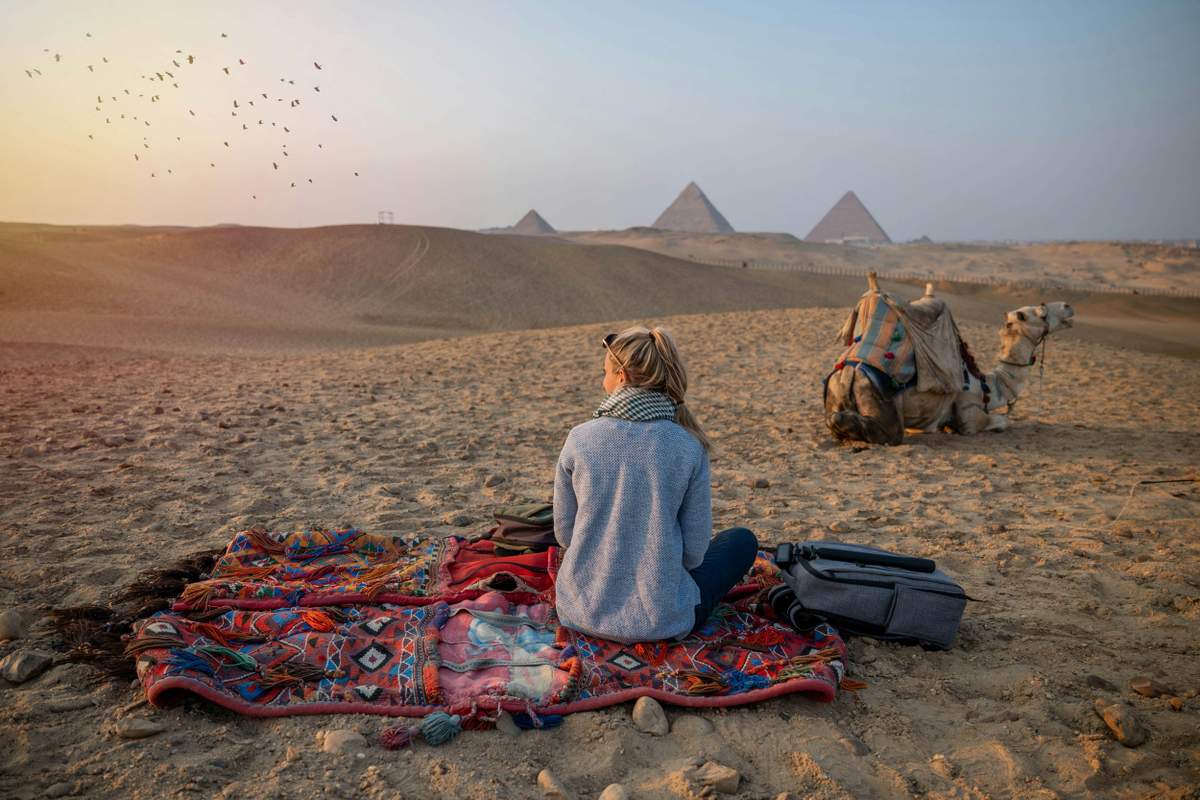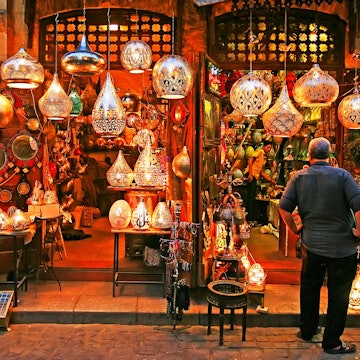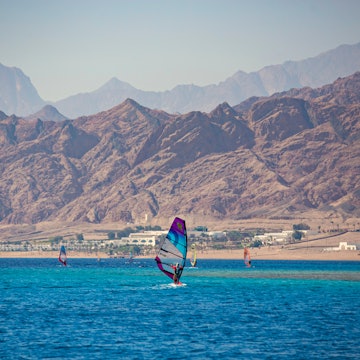
The best things to eat and drink in Egypt



A baker making aish baladi bread in Cairo, Egypt. Dietmar Temps/Shutterstock
Everybody knows about fuul (stewed fava beans) and ta’amiyya (the Egyptian version of falafel), but these street food favorites are just the starter menu for a richly satisfying, taste-bud-led journey through the cuisine of Egypt.
With its lack of frills, Egyptian food often slips under the radar when compared to the big-hitter regional cuisines of Lebanon, Türkiye and Iran, but there’s much to appreciate in its well-judged flavor combinations and use of home-grown ingredients. No matter when you visit Egypt, you’ll always find something interesting on the menu.
Be ready to be adventurous. Visitors often drop into a daily cycle of fuul, ta’amiyya and kebabs – but if you dig a little deeper, you’ll find creative cooking to rival anything in the region. Experience the imaginative takes on classic Egyptian dishes at Giza’s famed Khufu’s and you'll see what we mean!
Here’s everything you need to know about what to eat and drink in Egypt.

What is Egyptian cuisine?
Modern Egyptian menus include dishes that date back thousands of years, or even to the time of the pharaohs. Leavened and unleavened breads and dishes such as the jute-leaf soup molokhiyya and hamam mahshi (stuffed pigeon) were daily staples in the Pharaonic era and remain so to this day. The pita-like bread aish baladi is still the favored starch for Egyptian meals more than 6000 years after it was first created.
Egyptian food also reflects the country’s geographical location, with influences from across North Africa, the Mediterranean and the Middle East. Menus also show traces of the empires that ruled Egypt at various times in its history, from the ancient Greeks and Romans to Arab and Ottoman sultans and the French and British colonists who governed Egypt between 1798 and 1882.
For example, the popular dish macarona béchamel (baked pasta with ground meat and cheese sauce) is a local interpretation of the Greek dish pastitsio, while the popular street food shawarma (meat cooked on a vertical spit) has its origins in the Ottoman Empire and the Levant.
Despite these globe-trotting influences, Egyptians are keen enthusiasts for home-grown culinary traditions and akl beety (homemade food). One popular local tradition is cooking with samna, a ghee-like oil made by melting butter until the milk solids separate. Along the Nile Valley and in the Delta, samna crops up in everything from tasha (a sautéed mixture of garlic and ground coriander used as a seasoning) to the buttery Egyptian pastry known as fiteer.
Practical considerations such as the terrain and dry climate also come into play. Heat-tolerant species of pulses feature prominently in dishes such as fava-bean-based fuul and ta’amiyya and kushari (a mix of brown lentils, rice, pasta and chickpeas), providing cheap and satisfying sustenance for the masses.

Grab a traditional Egyptian breakfast
Egypt has its own distinctive breakfast dishes, though you won’t find a large selection of these on the buffet spread at your hotel. Instead, head to one of the hole-in-the-wall breakfast canteens or food carts you’ll find dotted around the streets.
At these humble eateries, you can feast on traditional dishes such as ta’amiyya (fava bean fritters) and fuul medames (stewed fava beans, spiced with cumin), typically served with aish baladi bread. Look out for side dishes such as mish (a pungent fermented cheese), beid bel basturma (eggs with dried beef) and betengan mekhalel (pickled aubergines).
If you fancy a portable breakfast, grab a ta’amiyya or fuul sandwich with salad, tahini and chips from a street-side vendor on your way to the next museum or monument.
Where to try it:
Close to the Nile Corniche in Garden City in Cairo, Mahrous has been around for around 70 years, and the grandson of its founder personally serves up full plates of its famous fuul to keen diners.
For a modern take on the traditional Egyptian breakfast, try ta’amiyya tossed with harissa raisin hot sauce at Zööba, a hip foodie stop with branches scattered around Cairo.
Close to Cairo’s Ramses Station, El Tabei El Domiaty does a roaring trade in shawarma and ta’amiyya from early each morning. Look for the red sign with white Arabic lettering.

Grab some Egyptian food on the go
Egypt’s busy bazaars are great places to find street food and perch-and-eat lunches to slot in between trips to the sights. Kebabs crop up everywhere; the umbrella term mashwiyat covers all sorts of meats grilled over charcoal. Alongside hunks of chicken, beef and lamb, be sure to try the local version of kofta, made from minced meat with garlic, spices and parsley.
Most travelers will be familiar with shawarma (grilled meat, sliced from a vertical spit) – alongside ta’amiyya sandwiches, this is Egypt’s most ubiquitous fast food dish. The Egyptian version uses chicken or lamb stuffed into a flatbread with chopped tomatoes and tahini (sesame paste). Also look out for hawashi, a pita-style sandwich filled with spiced ground beef and baked – it falls somewhere between a stuffed pastry and a Turkish lahmacun.
Offal is also enjoyed enthusiastically, though this can be an acquired taste. On the Mediterranean coast around Alexandria, chopped liver is fried with bell peppers, onions, and spices and served in a baguette-like bread called aish fino, showing the region’s French influences.

There’s more to Egyptian fast food than kebabs, of course, including plenty of options suitable for vegetarians. Fuul and ta’amiyya are excellent all-veg staples, and vegetarians can assemble a quick cafe lunch or dinner by ordering some flatbreads and Levantine-influenced mezze snacks such as bissara (cold fava-bean dip), baba ganoush (grilled aubergine dip) and sambousek (samosa-like pastries stuffed with cheese).
Fiteer is a flaky, layered pastry made with samna, sometimes described as an Egyptian pizza. At its most basic, it’s served plain with honey, molasses and ashta (cream), or a dip made from salty mish cheese. You’ll also find savory fillings such as ground beef, cheese, mixed vegetables, eggs and pastrami, and sweet fillings such as Nutella, lotus cream, custard and sugar.
Another veggie treat is kushari – a nutritious blend of macaroni or vermicelli noodles, rice, brown lentils, chickpeas and fried onions, smothered with a tangy tomato sauce. It’s a favorite quick fill-up for locals, usually served at dedicated kushari (or “koshary“) restaurants, which are easy to spot from the queuing diners.
Pescatarians and seafood lovers will dine like kings and queens on the Mediterranean and Red Sea coasts. Locally caught grouper, sea bass and mullet are casseroled, grilled with olive oil and lemon, or prepared singary-style (butterflied and topped with spiced vegetables).
Roadside vendors pop all sorts of fish-based treats inside flatbreads to make portable snacks. Look out for dishes made with shrimp, shellfish, squid, octopus and bisarya – silver-sided small fry, fried and eaten whole minus the heads.
Where to try it:
Koshary Abou Tarek on Champollion St in downtown Cairo has been in business for 70 years, and it continues to be celebrated as the home of the city‘s “best kushari.”
For fiteer, Feteera is centrally located on 26th July St in Cairo’s Zamalek district, with plenty of variations to try.
Cairo is well-stocked with kebab stops; head to Andrea El Mariouteya in New Giza for fabulous grilled chicken and quail accompanied by freshly baked aish baladi bread.
To sample authentic hawashi, follow the locals lining up for a daily dose atHawawshi El Rabie in Cairo’s Imbaba neighborhood, just northwest of Zamalek.
While in Alexandria, swing by Farag Fish, a few blocks inland from the waterfront on Hussain Tofik St, for top-notch seafood. House specialties include samak singary – oven-baked red snapper infused with flavors of coriander, garlic and green chili.
Visit Farag Abo Khaled on Alexandria’s waterfront for “the best liver in Egypt,” as the restaurant's neon sign proudly proclaims.
Open all hours, Koshari El Zaeem in Luxor is one of the top stops for kushari in the south; try the handy branch near the Lotus Bazar on the east bank of the Nile.

Experience the unique flavor of molokhiyya
Molokhiyya, a bright green soup made from broth and finely chopped jute leaves, has a glutinous consistency that some might call slimy. Still, it makes a highly nutritious meal and is much loved in Egyptian households. Molokhiyya is traditionally eaten with rice and often includes chicken or rabbit; in Alexandria and some other coastal cities, it is cooked with shrimp.
There are many stories about how the dish came into existence. The first mention in history dates from the 15th dynasty (around 1638 BCE), when the Hyksos dynasty ruled the northern part of Egypt. As the story goes, the Hyksos rulers forced ordinary people to eat the leaves of the jute plant as a form of punishment, but it soon became a favorite local food.
A rival story links the dish to the rulers of the Fatimid Caliphate, who reputedly claimed that the plant was poisonous to discourage the peasantry from eating it. Whatever the truth, Egyptians credit molokhiyya with many health benefits, including supporting the digestive and immune systems. Vegetarians should be aware that the dish often includes a meat-based broth.
In modern-day Egypt, molokhiyya is given extra flavor with tasha – a paste of minced garlic, coriander and cumin pan-fried in vegetable oil. While it’s still searing hot, the tasha is poured onto the molokhiyya, making a loud sizzling sound. As the tasha is poured, it’s traditional to take a shahqa (a deep, quick gasp), to inhale the aromas.
Other distinctive Egyptian dishes to look out for include tagens, tomato-based stews with meat or vegetables; and fatta, a mixture of rice, vegetables, hunks of boiled meat, and toasted pita bread topped with a garlicky tomato sauce or yogurt. In the Nile Delta region, scan menus for ruz me’ammar – rice combined with fresh cream, milk and samna, baked in a clay oven.
Where to try it:
South of the Tahya Misr bridge in Cairo, Sobhy Kaber brings the molokhiyya right to your table, then adds the tasha with a dramatic flourish. It’s so successful that branches are popping up around the region.
For the rabbit variety, try Abou El Sid in the upscale district of Zamalek to the north of Giza. Visiting diners such as Tom Hanks have raved about its flavors.
Part of the Lazib Inn Resort & Spa, Al Fayoum’s Blue Donkey serves upscale bowls of molokhiyya, excellent stuffed pigeon and tasty mezze plates with lovely lake views.

Sample Egypt’s stuffed vegetables and pigeon
The Egyptian tradition of mahshi refers to the stuffing of vegetables such as peppers, eggplants, zucchini, tomatoes, and grape or cabbage leaves. Seeds and pulp are scooped out, with the resulting cavity filled with rice seasoned with diced tomatoes, onion, herbs, spices and sometimes meat. The stuffed vegetables are then cooked in a pot topped up with broth.
The effort of preparation is seen as a gesture of respect to guests. Variations to look out for include mahshi kurumb (rolled and stuffed cabbage leaves) and wara ainab (rolled and stuffed grape leaves), which are similar to Turkish dolma and Greek dolmades. Some restaurants offer mixed platters, allowing you to try several different varieties.
A meal based on mahshi will typically feature several plates of stuffed vegetables and an array of other dishes. Roast duck is often served as the main course, and sometimes comes stuffed with seasoned short-grain rice as well. The head of the duck is considered to be a delicacy; if it is served, the hosts will offer it to their guests.
Another stuffed dish that is often served as a main course is hamam mahshi (roast pigeon stuffed with rice) – many restaurants choose this millennia-old delicacy as their showpiece dish. (The name has no connection to Turkish baths; hamam is the Egyptian Arabic word for pigeon.)
Tasha Restaurant in Cairo’s Garden City specializes in Egyptian home cooking, which covers everything from tagen stews and Alexandria-style liver to quality plates of mahshi.
For filling servings of mahshi near Giza, head to Dawar Om Hassan in the Dokki district; options include mixed plates, vine-leaf plates and stuffed-cabbage plates.
Over in Al Fayoum, Sit El Beit offers quality home cooking in the heart of the Tunis district. Come for mahshi, fiteer pastries and grilled pigeon.
Farahat is the place to go for stuffed pigeon in Cairo; there are several handy branches, including one near the Al-Azhar Mosque in Old Cairo.

Try tea and treats, plus other traditional drinks
Tea sweetened with heaps of sugar – usually served in a dainty glass – is Egypt’s favorite pick-me-up. Coffee is also hugely popular, served in thousands of ahwas (coffeehouses) across the country. Beyond these two staples, there are many more hot and cold drinks to enjoy in the country’s many cafes. Even locally made beers and wines are not hard to find in tourist-oriented restaurants and hotels.
Be sure to try some of the local plant-based coolers. Sahlab is a creamy drink made from milk, sugar and the powdered tubers of white orchids; it’s often decadently topped with cinnamon, pistachios or coconut. Other memorable drinks include karkadai, made from hibiscus flowers); carob juice; sugarcane juice; and seasonal juices made from mangos, guavas and the fruit of the doum palm.
Alongside hot and cold drinks, you'll find all sorts of sweet pastries and puddings to tempt your palate. The Egyptian bread pudding known as Om Ali (“Mother of Ali”) is made from layers of puff pastry soaked in sweetened milk and topped with nuts and golden raisins before being baked in the oven.
Other dessert treats to leave space for include basbousa (a semolina cake soaked in sugar syrup), ruz bi laban (spiced rice pudding) and mahallabiye (milk custard flavored with cardamom and rose water). Depending on how sweet your tooth is, you may also enjoy zalabya (dough balls dunked in honey or syrup) and the Egyptian version of kunafa (layers of filo pastry, wrapped around a sweetened cream or cheese filling).
With a broad list of local drinks and an extensive food menu, Naguib Mahfouz Café in Cairo’s Khan El Khalili market is a great refreshment spot.
To make karkadai at home, look out for bags of dried hibiscus flowers at the street markets in Aswan in Upper Egypt. Back home, simply brew the dried petals with hot water and a little sugar.
Cairo is a great place to graze on Egyptian desserts. Make space for Om Ali at Amir El Domiaty, basbousa at Mandarin Koueider, and ruz bi laban with dates at Cairo Kitchen.
Get a taste of the world depicted in Agatha Christie’s Death on the Nile at Terrace, in Aswan’s Sofitel Legend Old Cataract hotel. It’s a classy spot to enjoy a lavish English-style high tea while watching the Nile flow past.
This article was adapted from Lonely Planet’s Egypt guidebook, published in December 2025.















